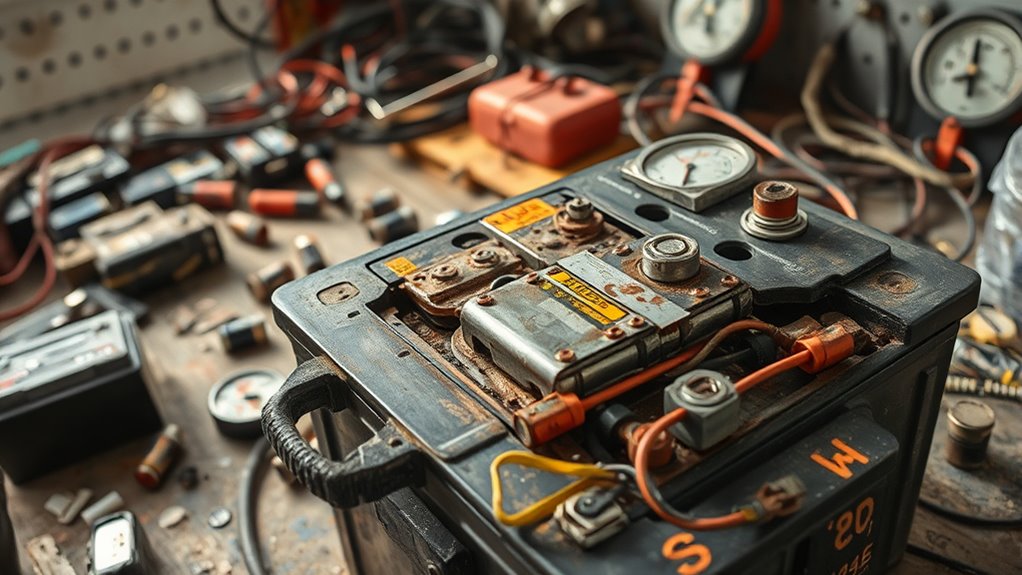One common mistake is skipping safety precautions, which can lead to chemical exposure or accidents. Always wear protective gear, work in ventilated areas, and handle batteries carefully. Another mistake is using improper tools or rushing procedures, risking damage or injury. Avoid rushing or improvising steps and follow trusted instructions closely. Many overlook thorough testing and maintenance, leading to incomplete reconditioning. Stay aware of risks, follow best practices, and you’ll increase your chances of success. More tips await as you continue.
Key Takeaways
- Failing to wear protective gear increases risk of chemical exposure and injuries; always use gloves and goggles.
- Using improper tools or makeshift equipment can damage batteries or cause safety hazards; employ insulated, correct tools.
- Not following manufacturer guidelines or trusted tutorials may lead to ineffective or dangerous reconditioning.
- Ignoring signs of battery damage, such as swelling or leaks, can cause accidents; only recondition healthy batteries.
- Rushing the process or skipping safety checks increases risks; prioritize patience, proper procedures, and safety measures.

Reconditioning batteries can be a cost-effective way to extend their lifespan, but many beginners make mistakes that can damage the battery or even pose safety risks. One of the most important aspects of safe reconditioning is understanding safety precautions. Batteries, especially lead-acid or lithium types, can release harmful chemicals or explode if mishandled. Before you start, make sure you’re in a well-ventilated area, wearing protective gear like gloves and safety goggles. Handling batteries without proper safety precautions can lead to burns, chemical exposure, or other injuries. Never work near open flames or sparks, as battery fumes are flammable. Always disconnect the battery from any device or charger before attempting reconditioning, to prevent electrical shocks or shorts.
Using the right tools is equally essential. Many beginners try to recondition batteries with makeshift equipment or without the proper tools, which can cause damage or safety hazards. Invest in a good multimeter to accurately check voltage and state of charge. You’ll also need insulated tools, like screwdrivers and pliers, to avoid accidental shorts. When dealing with terminals, use a wire brush or terminal cleaner to remove corrosion safely, and never use metal tools that could cause sparks. For reconditioning processes involving electrolyte handling, have a plastic or glass container ready, along with proper disposal materials for any waste. Using the wrong tools or improper techniques can damage the internal components of the battery or lead to dangerous leaks. Additionally, being aware of the best restaurants nearby can make your reconditioning sessions more enjoyable if you take breaks.
Always follow manufacturer guidelines or trusted tutorials when reconditioning batteries. Skipping steps or improvising can result in a failed reconditioning attempt or, worse, safety incidents. If you’re unsure about any step, it’s better to seek advice from experienced individuals or professional resources. Remember, safety should be your top priority—never rush through the process, and always double-check your setup before proceeding. Proper safety precautions and the correct tools not only protect you but also improve your chances of successfully reconditioning the battery without causing damage. By respecting these basic principles, you’ll make your battery reconditioning safer and more effective, saving money and extending your batteries’ life with confidence.
Frequently Asked Questions
Can Battery Reconditioning Be Safely Done at Home Without Experience?
Yes, you can safely do battery reconditioning at home if you follow proper DIY safety guidelines and have the right equipment essentials. Make sure to wear protective gear like gloves and goggles, work in a well-ventilated area, and understand the process thoroughly. Using appropriate tools helps prevent accidents, and taking your time guarantees safe handling. If you’re unsure, consider consulting detailed guides or videos before starting your reconditioning project.
What Are the Signs That a Battery Cannot Be Reconditioned?
You’ll know a battery can’t be reconditioned if a visual inspection reveals severe damage like cracks or corrosion, and you notice chemical leakage. These signs indicate the internal components are compromised beyond repair. If the battery’s case is swollen, leaking, or shows corrosion that can’t be cleaned, it’s best to avoid reconditioning. Attempting to fix such batteries could be unsafe and ineffective, so replacing them is the smarter choice.
How Long Does the Reconditioning Process Typically Take?
The reconditioning process usually takes anywhere from a few hours to a couple of days, depending on the battery type and condition. You can expect the reconditioning timeline to be quicker for smaller batteries like AA or 9V, while larger ones, such as car batteries, may require more time. The process duration involves careful charging, resting, and testing stages to guarantee maximum results, so patience is key.
Are There Specific Safety Precautions to Follow During Reconditioning?
You should always prioritize battery safety during reconditioning by wearing protective gear like gloves and goggles. Avoid contact with chemical hazards, as batteries contain corrosive substances that can cause burns or injuries. Work in a well-ventilated area to prevent inhaling harmful fumes. Carefully follow instructions, and never short-circuit or puncture batteries. These precautions help you stay safe and prevent accidents while effectively reconditioning your batteries.
Does Reconditioning Batteries Improve Their Lifespan Significantly?
Yes, reconditioning batteries can considerably improve their lifespan and battery capacity. When you carefully recondition a battery, you restore its ability to hold a charge, extending its overall lifespan. This process helps you get more use out of your batteries and saves money. Just make sure you follow proper techniques to avoid damaging the battery, ensuring that your efforts lead to genuine lifespan extension and improved performance.
Conclusion
By avoiding these common battery reconditioning mistakes, you can save time, money, and frustration. Imagine you’re reconditioning a car battery and forget to fully charge it afterward—your efforts could be wasted. Instead, follow proper steps like thorough charging and safety precautions. When you stay vigilant and learn from others’ errors, you’ll gain confidence and achieve better results. Keep these tips in mind, and you’ll extend your batteries’ life with ease.









